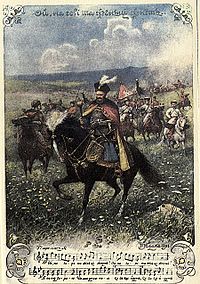| "Zaporizhian March" | |
|---|---|
 Postcard «Hey, on the hilltop those reapers reap» with musical note by Amvrosiy Zhdakha (1911) Postcard «Hey, on the hilltop those reapers reap» with musical note by Amvrosiy Zhdakha (1911) | |
| Instrumental | |
| Released | 1969 |
| Songwriter(s) | Oleksa Yushchenko [uk] |
| Composer(s) | Yevhen Adamtsevych |
Zaporizhian March (Ukrainian: Запорозький марш, romanized: Zaporoz'kyj marš) is an expressive Ukrainian folk musical composition that was preserved and revived by bandurist Yevhen Adamtsevych. The march became more famous after its arrangement by Viktor Hutsal [uk] who merged the march with the folk song about Doroshenko and Sahaidachny (Hey, on the hilltop the reapers reap [uk]).
Authenticity
It is widely accepted that the author of the famous «Zaporizhian March» alone is the Romny kobzar Yevhen Adamtsevych, a student of Musiy Oleksiyenko. In particular, it is confirmed via the correspondence of the researcher of kobzar performance O. Pravdyuk with the bandurist. In one letter to him Yevhen Adamtsevych wrote:
Now regarding Zaporizhian March.
In 1926 I heard the melody; the first part - from kobzar Ivan Kyrylovych Polozhai, the second part, the major one, I composed and after combining them together, gave the name to Zaporizhian March.
In addition the Yevhen Adamtsevych first performed it in public - to the general public march became known in 1969 thanks to the performance of the blind bandurist. Subsequently, the march for orchestra was arranged by the chief conductor of the State Orchestra of National Instruments, Viktor Hutsal. The main theme of the composition consists of syncopation and descending melodies which in the technique national bandurists played with fingers sliding on the strings that was first used by a bandura player Hnat Khotkevych in instrumental accompaniment for his composition of folk song about Baida («Poem of Baida», 1912), which he orchestrated in 1930.
Hypotheses regarding the origin of the work
- According to some assumptions, this work has been in the repertoire of teachers of Yevhen Adamtsevych Pavlo Ohrimenko [uk], a respected expert on creativity and heritage of the artist's performance believed that this march was co-authored with Musiy Oleksiyenko, and that the learning student picked up the first part of march from his teacher and further continued the melody creation. This, in particular, is according to the memoirs of Oleksiyenko's children.
- Also, some sources mention Prokop Mormilya, a native talent from the village Yaduty, Borzna Raion (now Nizhyn Raion), Chernihiv Oblast whom Yevhen Adamtsevych visited.
History
At first Yevhen Adamtsevych performed the march publicly in 1969 at a concert in the Kyiv Opera Theater of Taras Shevchenko.
Eyewitnesses described the concert so:
In incredible gravitation of hearts for the tune people were raising from their seats. There exploded yet unheard under that vault a thunder of ovations.
I can hardly express what happened after the first performance of "Cossack March". Let me just say that the old Adamtsevych performed it at the request of the public three times. So there was broken an agreement not to perform more than two pieces. And none of kobzars fellows blamed Adamtsevych that he repeated three times his performance. Although his music was wordless, but after an attentive listening to a melody "Zaporizhian March" none of the performers insisted on singing over the program.
It was clear: something extraordinary has just happened. Above the fascinated hall sparked and extinguished wonderful moment which to repeat, to hold no one would.
— Serhiy Kozak (People's Artist of Ukraine), Polyovyi, R. Romny kobzar Yevhen Adamtsevych. Sumy Historic Portal. "Democratic Ukraine". December 1993.
Yevhen Adamtsevych performed the march very expressively, vigorously, putting all his skills and emotional imagery. But the fact that he played by pinching lacked sonority. The conductor of State Orchestral Viktor Hutsal recollected:
I realized that this piece should sound at large scale and majestically. Writing a new march based on the old has become for me the primary objective.
On April 12, 1970 the orchestra performed the remake of the march at first. The artistic director and conductor Yakiv Orlov [uk] repeated the piece ou bis several times. Thus until 1974 the «Zaporozhian March» was performed at all concerts several times. The public always welcomed musicians standing. The composition became more famous after it was included in the soundtrack of the Borys Ivchenko film «Propala Hramota» (Vanished Document) in 1972. After performing the march at the Bolshoi Theatre (Moscow), it became an interest of party leaders who worried about a very heightened spiritual atmosphere among the audience. Communists have carefully studied the notes checking them with songs of Sich Riflemen. Although nothing was found, the march was banned. While Hutsal had to resign and join another group.
Performance
- Since 1984 the Zaporizhian March was allowed to be performed. It became to sound at rallies during the struggle for independence in the late 1980s. The sounds of the march assemble deputies in the Verkhovna Rada.
- Under S. Tvorun arrangement it is also one of the main marches of the Armed Forces of Ukraine named «Cossack march». After 1991, this march replaced «Farewell of Slavianka» on recruitment days and open houses of the Armed Forces.
- «Zaporizhian March» entered the repertoire of the National Orchestra of National Instruments.
See also
Further reading
- Dibrova, H. Romny kobzar Musiy Oleksiyenko. "National art and ethnography". 1991.
References
- Donchenko, A. History of Prokop Mormilya, a creator of the "Zaporozhian March". Chernihiv portal. August 17, 2009.
- ^ Melnyk, O. Godfather of the "Zaporizhian March". All-Ukrainian political educational weekly "Personal Plus". September 28, 2006.
External links
- The Godfather of the Zaporizhian March
- March of the Zaporozhian Cossacks. "With Fire and Sword". YouTube.
- "Zaporozhian March"/"Запорозький марш". Orchestra. YouTube.
- "Hey, on the hilltop those reapers reap" by the State Merited Capella of Bandurists of Ukraine. YouTube.
| Symbols of Ukraine | ||
|---|---|---|
| Official |  | |
| Unofficial | ||
| Songs | ||
| People | ||
| Landmarks | ||